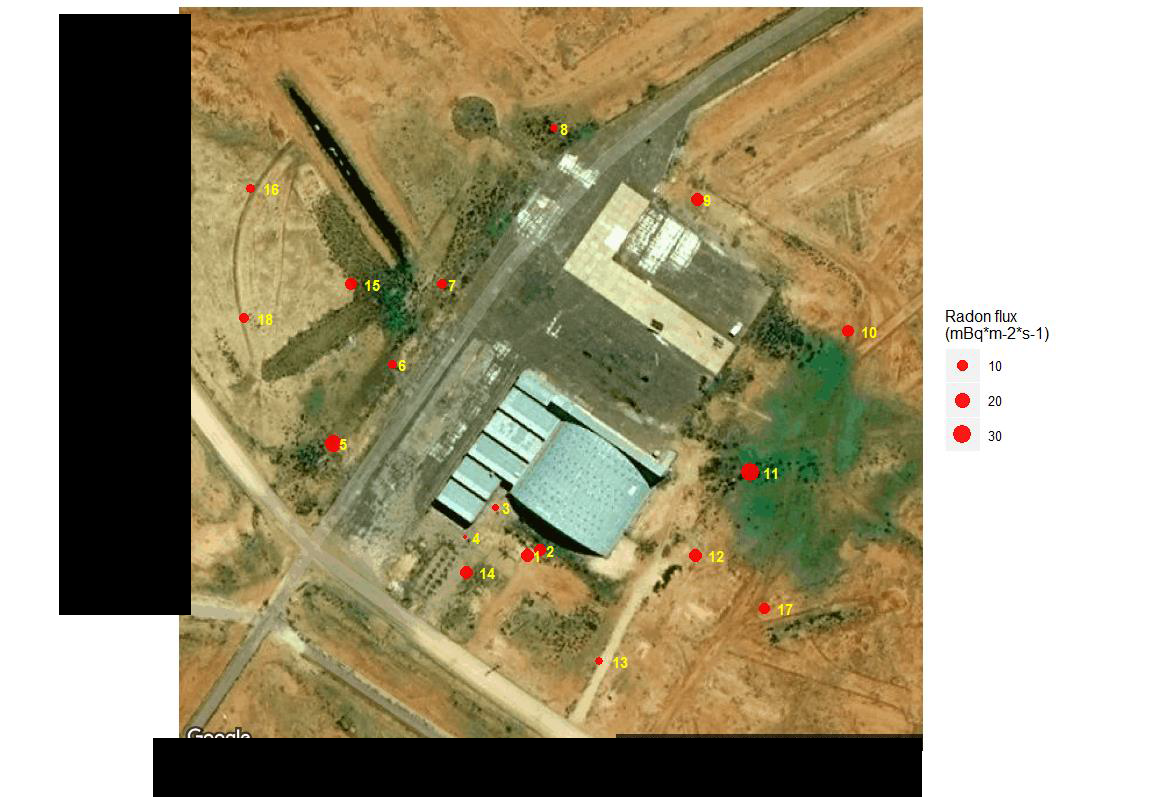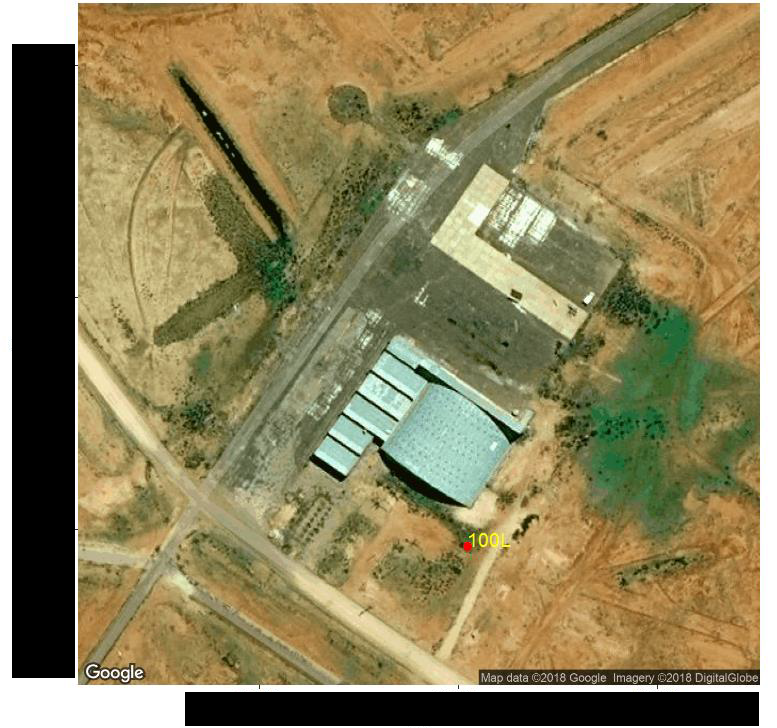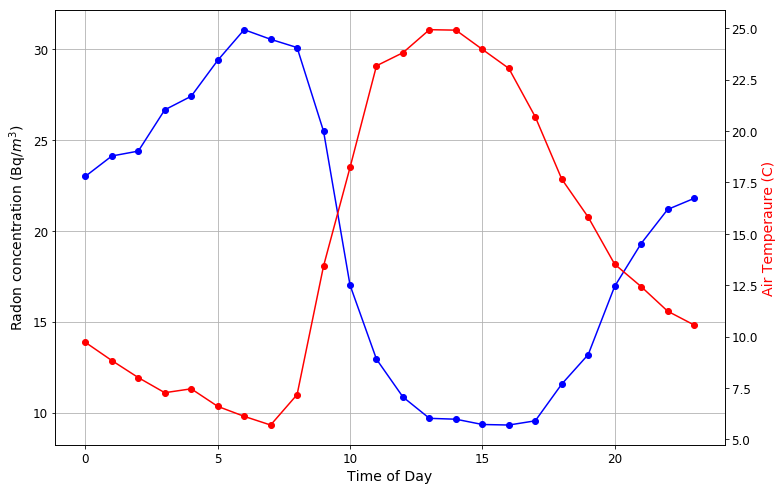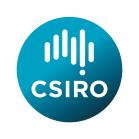 [FOR-OFFICAL-USE-ONLY]
[FOR-OFFICAL-USE-ONLY]
RELEASED
BY ARPANSA
REPORT ON RADON EMISSIONS FROM SOIL AND RADON
IN OUTDOOR AIR AT WOOMERA AREA
October 2018
UNDER
FOI
FEBRUARY
Sylvester Werczynski
2019
 [FOR-OFFICAL-USE-ONLY]
[FOR-OFFICAL-USE-ONLY]REPORT ON RADON EMISSIONS FROM SOIL AND RADON IN
OUTDOOR AIR AT WOOMERA AREA
Introduction
Measurements of emissions from soil of radon-222 (radon) and radon-220 (thoron) as well as
ambient air radon have been performed at the Woomera Defence site between end of May and
beginning of September 2018 as part of the baseline monitoring of the site and to measure
potential occupational radiological exposures. Soil emissions were measured using a portable
RELEASED
accumulation chamber, and radon in air measured using a dual-flow-loop two-filter radon detector
(Whittlestone and Zahorowski1, 1998; Chambers et al., 20112).
During the week of 29th -31st May 2018, 18 different locations on the site of interest were selected
for spot measurements of radon emissions from soil. In addition, a 100L detector was set up on
the southern side of the survey area to monitor radon concentrations continuously with a time
resolution of 1 hour. BY
Radon flux survey ARPANSA
In order to characterise the surface radon emissions from soil at the area of interest, the ANSTO
radon emanometer3 was used. The instrument is designed to simultaneously measure the radon
and thoron flux densities from soil or rock surfaces. Radon and thoron flux estimates are made
based on the flow-through accumulator method, with each sample taking approximately 24
minutes.
The strength of radon emissions from the land surface into the atmosphere depends on the soil
UNDER
mineralogy and porosity, and to a lesser extent also varies with changes in atmospheric pressure
and soil moisture. Roughly speaking, the instantaneous flux should be within around a factor of
two of the long term mean4.
The ANSTO portable accumulation chamber allows radon to accumulate in a chamber placed over
FOI
the soil. The evolution of the measured radon concentration within the chamber is continuously
monitored, and the surface flux at that location can then be estimated from the accumulation rate.
FEBRUARY
2019
1 Whittlestone, S. and Zahorowski, W.: Baseline radon detectors for shipboard use: development and deployment in the First Aerosol
Characterization Experiment (ACE 1), J. Geophys. Res., 103,
16743–16751, doi:10.1029/98JD00687, 1998.
2 Chambers, S., Wil iams, A. G., Zahorowski, W., Griffiths, A., and Crawford, J.: Separating remote fetch and local mixing influences on
vertical radon measurements in the lower atmosphere,
Tel us B, 63, 843–859, doi:10.1111/j.1600-0889.2011.00565.x, 2011.
3 Zahorowski, W. and Whittlestone, S.: A Fast Portable Emanometer for Field Measurement of Radon and Thoron Flux, Radiat. Protect.
Dosim., 67, 109–120, 1996
4 Holford, D. J., Schery, S. D., Wilson, J. L., and Phil ips, F. M.: Modeling Radon Transport in Dry, Cracked Soil, J. Geophys. Res., 98,
567–580, doi:10.1029/92JB01845, 1993
REPORT ON RADON EMISSIONS FROM SOIL AND RADON IN OUTDOOR AIR AT WOOMERA AREA
Page | 1


 [FOR-OFFICAL-USE-ONLY]
[FOR-OFFICAL-USE-ONLY]REPORT ON RADON EMISSIONS FROM SOIL AND RADON IN
OUTDOOR AIR AT WOOMERA AREA
RELEASED
BY ARPANSA
Fig.1. View of ANSTO portable radon emanometer
UNDER
FOI
FEBRUARY
Fig.2. View of accumulation chamber during radon flux measurement
The radon emanometer was calibrated at ANSTO prior to sending it to the survey site.
Most of the survey points were located outside the fence of the area of interest. The points 3 and
2019
4 were located inside the compound on the weathered bitumen, hence their low values.
The average radon emanation values around the site is 12 mBq m-2 s-1 and average thoron values
of 3200 mBq m-2 s-1, which are comparable to Australian average radon emanation from soils
(radon: 23.4 mBq m-2 s-1, thoron: 1700 mBq m-2 s-1)5 6.
5 Schery, S., Whittlestone, S., Hart, K., and Hil , S.: The flux of radon and thoron from Australian soils, J. Geophys. Res, 94, 8567–
8576, doi:10.1029/JD094iD06p08567, 1989.
6 Griffiths A. D, Zahorowski W, Element A, Werczynski S. A map of radon flux at the Australian
REPORT ON RADON EMISSIONS FROM SOIL AND RADON IN OUTDOOR AIR AT WOOMERA AREA
Page | 2
 [FOR-OFFICAL-USE-ONLY]
[FOR-OFFICAL-USE-ONLY]REPORT ON RADON EMISSIONS FROM SOIL AND RADON IN
OUTDOOR AIR AT WOOMERA AREA
The table below summarises the measured radon emissions (May 2018):
No Latitude
Longitude
Soil moisture
Radon
Error
Thoron
Error
%
mBq m-2s-1 mBq m-2s-1 mBq m-2s-1 mBq m-2s-1
RELEASED
s 33 - security
12.8
15.5
1.33
2641
53.8
9.7
11.4
1.45
2003
48.9
10.3
4.3
1.26
760
36.6
10.7
2.6
1.19
1886
47.5
BY
7.1
24.8
1.69
3167
61.1
ARPANSA
4.1
7.2
1.46
4256
67.8
5.5
9.1
1.29
3477
62.2
7.4
4.7
1.23
4899
71.4
2.4
14.1
1.45
2106
52.9
10.3 UNDER
10.6
1.48
2964
59.1
1.4
30.1
1.67
2224
54.9
6.6
15.3
1.71
3278
63.7
3.8
5.2
1.71
FOI 2610 58.5
1.9
14.3
1.80
2402
58.1
FEBRUARY
5.8
12.4
1.88
4203
71.1
3.3
6.4
1.58
2661
58.4
10.5
10.3
1.63
3606
65.6
8.8
7.7
1.65
4882
75.4
2019
Table 1. Radon emanation survey results
land surface. Atmos. Chem. Phys. 2010; 10: 8969–8982. 10.3402/tel usb.v65i0.19622.
REPORT ON RADON EMISSIONS FROM SOIL AND RADON IN OUTDOOR AIR AT WOOMERA AREA
Page | 3

 [FOR-OFFICAL-USE-ONLY]
[FOR-OFFICAL-USE-ONLY]REPORT ON RADON EMISSIONS FROM SOIL AND RADON IN
OUTDOOR AIR AT WOOMERA AREA
s 33 -
security
RELEASED
BY ARPANSA
UNDER
s 33 - security
Fig.3. Radon flux survey map
FOI
FEBRUARY
Radon in air measurements
In order to measure the 222Rn concentrations in air, ANSTO continuous 100L dual-loop radon-in-air
detector has been set up with AlphaGUARD portable radon monitor as a backup.
The 100L detector had been set up at the southern part of the survey area and close to the
2019
buildings ats 33 - security
REPORT ON RADON EMISSIONS FROM SOIL AND RADON IN OUTDOOR AIR AT WOOMERA AREA
Page | 4

 [FOR-OFFICAL-USE-ONLY]
[FOR-OFFICAL-USE-ONLY]REPORT ON RADON EMISSIONS FROM SOIL AND RADON IN
OUTDOOR AIR AT WOOMERA AREA
s 33 -
security
RELEASED
BY ARPANSA
UNDER
FOI
s 33 - security
Fig.4. Location of the 100L radon detector
FEBRUARY
Air sampled from an air intake mounted 2m above ground level at the rate of 18 L/min first passes
through an air filter to remove dust or other aerosol pollution, as well as ambient radon progeny
(products of radon’s radioactive decay process) in the sampled air stream.
The air then enters the thoron delay volume (black barrel on figure 4). Thoron (220Rn) is an isotope
of radon (222Rn) and can interfere with the measured radon signal. As the half-life of thoron is only
55.6 seconds, it is almost completely removed by delaying the sampled air in these thoron delay
2019
volumes by 6 minutes.
After exiting the thoron delay volume, air enters the main delay volume (metal tank on figure 5),
which allows radon to decay under controlled conditions. From there the air passes through a
screen, which collects the newly formed decay products. The screen sits close to a zinc sulphide
scintillator, which emits light when struck by alpha particles from radon decay. The scintillator is
connected to a photomultiplier tube which detects this light. This detection is processed
electronically and recorded as a count rate by a data logger.
The detector was set up with solar panels charging a 12V battery, which run the instrument.
REPORT ON RADON EMISSIONS FROM SOIL AND RADON IN OUTDOOR AIR AT WOOMERA AREA
Page | 5

 [FOR-OFFICAL-USE-ONLY]
[FOR-OFFICAL-USE-ONLY]REPORT ON RADON EMISSIONS FROM SOIL AND RADON IN
OUTDOOR AIR AT WOOMERA AREA
The datalogger in the 100L radon detector is also configured to continuously monitor the ambient
air temperature, relative humidity, barometric pressure, and wind speed and wind direction.
s 33 - security
RELEASED
BY ARPANSA
Fig.5. 100L radon detector located at survey site
Due to its location, the battery for the 100L detector could not be fully charged every day,
resulting in incomplete data set. Where necessary, the data from the backup portable radon
UNDER
monitor AlphaGUARD was used.
Three full months of radon data is available, both from the 100L detector and the backup
AlphaGUARD monitor (Figure 5).
FOI
FEBRUARY
2019
Fig.5. Hourly 222Rn concentration in the air at 2 m above the ground at Woomera site
REPORT ON RADON EMISSIONS FROM SOIL AND RADON IN OUTDOOR AIR AT WOOMERA AREA
Page | 6

 [FOR-OFFICAL-USE-ONLY]
[FOR-OFFICAL-USE-ONLY]REPORT ON RADON EMISSIONS FROM SOIL AND RADON IN
OUTDOOR AIR AT WOOMERA AREA
Figure 5 shows the variation of hourly outdoor radon concentration in the atmosphere for the
period from June to September 2018.
Total and monthly radon concentration statistics for the site, based on a 60 min data integration
period, is shown in Table 2 and Figure 6.
RELEASED
Average
SD
Max
All
19.4
16.0
136.0
Jun-18
24.2
19.6
136.0
Jul-18
19.9
15.3
119.5
Aug-18
14.8
11.5
122.5
Table 2. Radon concentration statistics at the site
BY
50
45
ARPANSA
)
3
40
/m
35
(Bq
n
30
o
ti
25
Average
tra
n
20
10pc
e
c
n
15
90pc
o
c
UNDER
10
n
o
5
Rad
0
Jun-18
Jul-18
Aug-18
Sep-18
Figure 6: Monthly distributions (10th percentiles, average and 90th percentiles) of radon concentrations [Bq
m-3] at the site.
FOI
FEBRUARY
2019
Figure 7: Monthly distributions of radon concentrations with outliers
REPORT ON RADON EMISSIONS FROM SOIL AND RADON IN OUTDOOR AIR AT WOOMERA AREA
Page | 7

 [FOR-OFFICAL-USE-ONLY]
[FOR-OFFICAL-USE-ONLY]REPORT ON RADON EMISSIONS FROM SOIL AND RADON IN
OUTDOOR AIR AT WOOMERA AREA
The diurnal pattern of 222Rn concentration was revealed with a maximum in the early morning and
a minimum in the afternoon (Fig. 8). This diurnal variation of radon concentration resulted from
the formation of a surface thermal inversion at night and high turbulence in the daytime mixing
layer.
RELEASED
BY ARPANSA
UNDER
Fig.8. Mean of 24 h pattern of 222Rn concentration in the air and air temperature at 2 m above the ground at
the site
The 100L detector is fitted with a wind speed and direction sensor (Windsonic) because of the
FOI
large effect that meteorological conditions have on ambient radon concentration. In particular, the
mixing height (the depth of the well-mixed layer near the ground) determines the height over
which fresh radon emissions are distributed. At inland sites, the highest near-surface radon
FEBRUARY
concentrations are typically seen on calm, clear nights when mixing may be limited to a few tens
of metres.
The wind rose plot (Fig.9) shows the prevalent wind speed and direction at the location of 100L
detector during the measurements. Although local radon emissions are relatively low, airborne
radiometric surveys7 indicate the potential for higher radon emissions from the westerly sector,
from south west through to north east of the site8. This is confirmed on the percentile rose plot
(Fig.10).
2019
7 Radiometrics map:
Radium data are taken from the Radiometric Map of Australia (Radmap 2009: Minty et al., 2009).
Minty, B. R. S., Franklin, R., Milligan, P. R., Richardson, L. M., and Wilford, J.: The Radiometric Map of Australia, in: 20th International
Geophysical Conference and Exhibition, Australian Society of Exploration Geophysicists, Adelaide, 2009
Radon flux data are from Griffiths et al. 2010
8 "airborne radiometric surveys" are the basis of "The Radiometric Map of Australia"
REPORT ON RADON EMISSIONS FROM SOIL AND RADON IN OUTDOOR AIR AT WOOMERA AREA
Page | 8


 [FOR-OFFICAL-USE-ONLY]
[FOR-OFFICAL-USE-ONLY]REPORT ON RADON EMISSIONS FROM SOIL AND RADON IN
OUTDOOR AIR AT WOOMERA AREA
RELEASED
BY ARPANSA
UNDER
Fig.9. Wind rose plot - frequency of counts by wind direction (%)
FOI
FEBRUARY
2019
Fig.10. Percentile rose plot of radon concentrations
REPORT ON RADON EMISSIONS FROM SOIL AND RADON IN OUTDOOR AIR AT WOOMERA AREA
Page | 9
 [FOR-OFFICAL-USE-ONLY]
[FOR-OFFICAL-USE-ONLY]REPORT ON RADON EMISSIONS FROM SOIL AND RADON IN
OUTDOOR AIR AT WOOMERA AREA
Conclusions
No measured radon concentrations at the site exceeded the recommended action levels for
workplaces and dwellings9.
Reduction in the monthly average radon concentrations at the site over the study period is
RELEASED
likely due to stronger mixing associated with higher wind speeds and overcast conditions.
The radon emanation from the soil at the site is comparable to Australian average radon
emanation from soils.
Final Comments
BY
The 100L radon detector was calibrated at ANSTO in April 2018 before shipping to the survey site.
ARPANSA
To ensure detector’s integrity after completing the measurements and shipping by road back to
ANSTO, it supposed to be re-calibrated again in October 2018. After it arrived at ANSTO, it’s been
found to be damaged during the transport, as the voltage divider on the PM tube was broken and
squashed. The repair could not be done on the detector, due to the technician being on holidays
all October. Even repaired, the new voltage divider would need to be characterised again, and it
could differ from the original state.
UNDER
The repairs on the detector will take 4-5 hours with 1-2 more days required for characterisation of
the repaired system.
As a result, most of the data available for the site radon concentration were obtained from the
backup radon detector AlphaGUARD, which contained a full data record for the duration of the
survey.
FOI
FEBRUARY
2019
9 ARPANSA, 2017: Radiation Protection Series G-2, Guide for Radiation Protection in Existing Exposure Situations (September 2017),
Annex A. Available at:
https://www.arpansa.gov.au/regulation-and-licensing/regulatory-publications/radiation-protection-series/guides-
and-recommendations/rpsg-2
REPORT ON RADON EMISSIONS FROM SOIL AND RADON IN OUTDOOR AIR AT WOOMERA AREA
Page | 10

 Appendix 2
Radiation Risk Control Plan
ALL purchases, disposal and proposed changes to operate must be discussed with the
site/Division Radiation Safety Officer before proceeding
This Radiation Risk Control Plan is to be attached to the relevant HSE Risk Management Plan
Appendix 2
Radiation Risk Control Plan
ALL purchases, disposal and proposed changes to operate must be discussed with the
site/Division Radiation Safety Officer before proceeding
This Radiation Risk Control Plan is to be attached to the relevant HSE Risk Management Plan
RELEASED
Program/Group/Team B&IS WA/SA/NT Irymple Region
Site/Location CSIRO Woomera Test
(ie
Range
building/lab)
Business Unit
CSIRO Business and Infrastructure Services
Assessment 28/10/18
Date
Manager (ie Project
Dave Agnew
Date of next October 2018
leader)
review
Link to relevant HSE B&IS Risk Management Plan – Woomera Site Activities
TRIM file
risk Management
number
BY
plan (reference
number)
ARPANSA
Review and Approvals
Manager (ie Project Leader)
Name:
Dave Agnew
Signature
Date:
Site Radiation Safety Officer
Name:Jeffrey Sheridan
Signature
Date:
Reviewed by Divisional
Name:Jeffrey Sheridan
Signature:
Date:
UNDER
RSO
Divisional RSO review checklist:
FOI
Checklist
Required
TRIM number
Yes or No
(if applicable)
FEBRUARY
Part A
Updates to source or facility licence required
No
and B
Review of the control systems in place for all controlled
Yes
material and controlled apparatus
Environmental impacts- State jurisdiction regulator
No
approval for waste disposal
Updates to Emergency plans required
No
2019
Part C
Review training needs of the workgroup
Yes
Part D
Review ASNO requirements ( if applicable)
No
Reference (PRO021) – Version 1.3
CSIRO Enterprise Document – Internal use Only
page 1 of 9
This document is a controlled document. The controlled document is maintained electronically by CSIRO Governance Office and is available at
http://intranet.csiro.au/intranet/policy/policy.htm. Any printed copy of this document is an uncontrolled copy.
RELEASED
Part A Ionising Radiation: Please consult with site/Divisional RSO for information on the ARPANSA Divisional source inventory workbook
A1: Unsealed sources: (eg 14C, Co60, U238, I125 )
Source
Type of
Intended
Form
Maximum Activity (MBq)
Location
Inherent risk
licence
Unsealed
purpose
number
(insert from HSE risk
source
Physical Chemical
At any one time
Total for one
(discuss with
Management plans)
BY
RSO)
(liquid or
Compound
year
(eg 14C)
solid)
ARPANSA
Unsealed
Th and U natural
Hangar 5
S0013
Waste -
11900 MBq
High
source, or
Annex Evatts
sources, in
awaiting
Field. SA 5720
a
disposal
laboratory
or
premises,
having
nuclides
UNDER
such that
when the
maximum
activity of
each
nuclide in
FOI
the source
or sources,
is divided
FEBRUARY
by the
amount
mentioned
in column 4
of Part 2 of
Schedule 2
for that
kind of
nuclide, the
2019
total of the
Reference (PRO021) – Version 1.3
CSIRO Enterprise Document – Internal use Only
page 2 of 9
This document is a controlled document. The controlled document is maintained electronically by CSIRO Governance Office and is available at http://intranet.csiro.au/intranet/policy/policy.htm. Any
printed copy of this document is an uncontrolled copy.
RELEASED
results for
all nuclides
in the
source, or
sources, is
more than
10000 but
not more
BY
than
100000
ARPANSA
A2: Sealed sources: (eg Calibration standards)
Source
Type of
Intended
Encapsula
Security
Fixed, mobile
Location
Manufact
Serial &
Recommen
Inherent
licence
sealed
purpose
tion
or portable
(building
urer
ded
risk
UNDER
number
Category
model
source
(select one)
/lab
working life
(discuss
Matter
number
(insert from
number)
with RSO)
HSE risk
Management
plans)
FOI
FEBRUARY
A3: Ionising apparatus: (eg x-ray, XRF )
Source
Type of ionising
Intended
Manufacturer Model
Fixed,
Location
Operating
Inherent risk
licence
apparatus
purpose
number
portable or
(building/lab parameters
number
(insert from HSE risk
mobile
no)
(discuss
Management plans)
(select one)
with RSO)
KVp
mA
2019
Reference (PRO021) – Version 1.3
CSIRO Enterprise Document – Internal use Only
page 3 of 9
This document is a controlled document. The controlled document is maintained electronically by CSIRO Governance Office and is available at http://intranet.csiro.au/intranet/policy/policy.htm. Any
printed copy of this document is an uncontrolled copy.
RELEASED
BY
ARPANSA
Part A Ionising radiation – controls
Controls
Description of controls used
Controls
Description of controls used
(provide further information on the controls
(provide further information on the
selected in column b)
controls selected in column e)
Emergency response plan
Emergency response is controlled by
TLD badges
TLD badges used for individuals entering the
g
s
Defence as landlord. All CSIRO staff
n
store area are assessed quarterly, electronic
ncy
ol
Emergency Equipment (e.g.
visiting the site complete an electronic
lth
UNDER
Neutron film badge
personal dosimeters also made available to staff
shields)(specify)
a
tori
rge
induction for familiarity.
e
on site.
e
ontr
H
ni
Thyroid count (125I)
m
C
Spill kits
Mo
E
Segregation
Stored in Defence force controlled facility in
Licence conditions reviewed annually
s
locked isolated location.
Controls identified in plant risk control
Contamination surveys of surrounding air
ure
Radiation laboratory
plan
and soil, conducted in May 2018 to be
s
Shielding (e.g. portable perspex shield
repeated on any change of activities (eg
FOI
Personal Protective
or inbuilt)
moving materials).
l Mea
Equipment Required during
ls
Radon monitoring underway 2018 within
o
o
transport (please specify
Isolation/Lock out/interlocks
the store to establish levels.
ontr
ontr
FEBRUARY
C
Transport Plan/Requirements
C
Contamination surveys
(attach additional information if
Decay holding tanks
required)
ting
Locked Storage Cabinet/Box
nsport
ra
ra
Approval to move sources
Safe work instructions
/ T
Ope
Personal Protective Equipment
ge
Training in use of the apparatus
tora
S
Other (e.g. specific licence conditions)
2019
Reference (PRO021) – Version 1.3
CSIRO Enterprise Document – Internal use Only
page 4 of 9
This document is a controlled document. The controlled document is maintained electronically by CSIRO Governance Office and is available at http://intranet.csiro.au/intranet/policy/policy.htm. Any
printed copy of this document is an uncontrolled copy.
RELEASED
Controls
Description of controls used
Controls
Description of controls used
(provide further information on the controls
(provide further information on the
selected in column b)
controls selected in column e)
Placed into storage and RSO
Wipe testing
(note source number and
notified
Annual perimeter survey undertaken of facility by
frequency of wipe tests including last
Annual assessment of facility and
contactors and maintenance undertaken as
result)
radiological survey undertaken.
Rendered permanently
required..
4 yearly environmental status report
inoperable and scrapped
Contamination surveys
provided to ARPANSA by CH2M Hill in
2017. CSIRO Environmental baseline
BY
Return to supplier/distributor
Interlock/Shielding checks
results shared with ARPANSA 2018.
e
l
Regulator-approved disposal
Other (specify)
nanc
ARPANSA
posa
method
e
is
Reviewed annaully Reviewed
nt
D
annaully Storage to allow decay
Mai
Disposal via approved contractor
Local waste management plan in
place ( approval from local authority)
UNDER
** Any controls not in place are noted in part E: Radiation improvement action list
Part B – Non Ionising Radiation (List all types of NIR used by the workgroup under CSIRO control)
(eg: Transilluminators, water purifiers, lasers, biological safety cabinets)
FOI
Source
Type of
Intended
Manufacturer
Model
Fixed or
Location
Type of NIR /Output
Inherent risk
licence
controlled
purpose
number/serial
portable
(building/lab
parameters
(insert from HSE
number
apparatus ( ie
number
number)
Risk Management
FEBRUARY
(discuss with
biohazard
plan)
RSO)
cabinet)
2019
Reference (PRO021) – Version 1.3
CSIRO Enterprise Document – Internal use Only
page 5 of 9
This document is a controlled document. The controlled document is maintained electronically by CSIRO Governance Office and is available at http://intranet.csiro.au/intranet/policy/policy.htm. Any
printed copy of this document is an uncontrolled copy.
RELEASED
Part B Non Ionising radiation – controls
To be completed for each group of controlled apparatus
Controls
Description of controls used
Controls
Description of controls used
(provide further information on the controls
(provide further information on the
selected in column b)
controls selected in column e)
Emergency response plan
BY
Laser safety eye tests
g
s
n
ncy
ol
Emergency Equipment (e.g.
lth
Other
shields)(specify)
a
tori
rge
e
ARPANSA
e
ontr
H
ni
m
C
Other (specify)
Mo
E
Locked storage cabinet
Controls identified in plant risk control
Fully enclosed, interlocked
plan
s
cabinet
ure
Shielding (e.g. portable perspex shield
s
Personal Protective
or inbuilt)
Equipment Required during
UNDER
l Mea
transport (please specify
ls
Isolation/Lock out/interlocks
o
o
ontr
Transport Plan/Requirements
ontr
C
(attach additional information if
C
Other monitor/Alarm (eg laboratory gas
required)
alarm)
ting
Locked Storage Cabinet/Box
nsport
ra
ARPANSA approval to move
ra
controlled apparatus
Safe work instructions
FOI
/ T
Ope
ge
Personal Protective Equipment
tora
S
Training in use of the apparatus
FEBRUARY
Other (e.g. specific licence conditions)
2019
Reference (PRO021) – Version 1.3
CSIRO Enterprise Document – Internal use Only
page 6 of 9
This document is a controlled document. The controlled document is maintained electronically by CSIRO Governance Office and is available at http://intranet.csiro.au/intranet/policy/policy.htm. Any
printed copy of this document is an uncontrolled copy.
RELEASED
Controls
Description of controls used
Controls
Description of controls used
(provide further information on the controls
(provide further information on the
selected in column b)
controls selected in column e)
Placed into storage and RSO
notified
e
Interlock/Shielding checks
l
Rendered permanently
inoperable and scrapped
nanc
Other (specify)
posa
e
is
nt
BY
D
Return to supplier/distributor
Mai
Regulator-approved disposal
ARPANSA
method
** Any controls not in place are noted in part E: Radiation improvement action list
UNDER
Part C: Training requirements:
Staff name
Describe training undertaken
Attained:
Refresher due:
FOI
Jeffrey Sheridan
Radiation Safety Officer training
FEBRUARY
2019
Reference (PRO021) – Version 1.3
CSIRO Enterprise Document – Internal use Only
page 7 of 9
This document is a controlled document. The controlled document is maintained electronically by CSIRO Governance Office and is available at http://intranet.csiro.au/intranet/policy/policy.htm. Any
printed copy of this document is an uncontrolled copy.
RELEASED
Part D ASNO
CSIRO Divisions that use or possess
natural uranium, depleted uranium (eg uranyl acetate), Uranium233, low or high enriched uranium
or Thorium and may have duties under the Nuclear Non proliferation (safeguards) Act and Regulations. Depending on holdings a permit
maybe required to store use and transport the material.
(Radiation safety officers to confirm material held is on the appropriate permit)
Type of material
Quantity held (Kg)
Permit number ( if known)
BY
ARPANSA
UNDER
FOI
FEBRUARY
2019
Reference (PRO021) – Version 1.3
CSIRO Enterprise Document – Internal use Only
page 8 of 9
This document is a controlled document. The controlled document is maintained electronically by CSIRO Governance Office and is available at http://intranet.csiro.au/intranet/policy/policy.htm. Any
printed copy of this document is an uncontrolled copy.
RELEASED
Part E – Radiation Improvements Action List
BY
Updated: insert Date
ARPANSA
No
Action
Person
Action by
Date Completed
Comment
Responsible
1
2
3
UNDER
4
5
FOI
FEBRUARY
2019
Reference (PRO021) – Version 1.3
CSIRO Enterprise Document – Internal use Only
page 9 of 9
This document is a controlled document. The controlled document is maintained electronically by CSIRO Governance Office and is available at http://intranet.csiro.au/intranet/policy/policy.htm. Any
printed copy of this document is an uncontrolled copy.





















